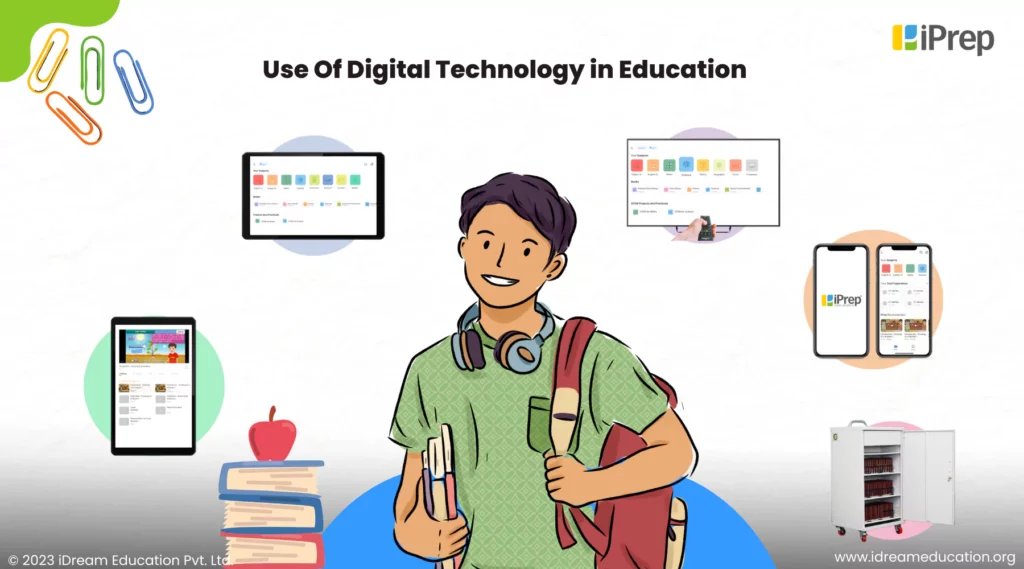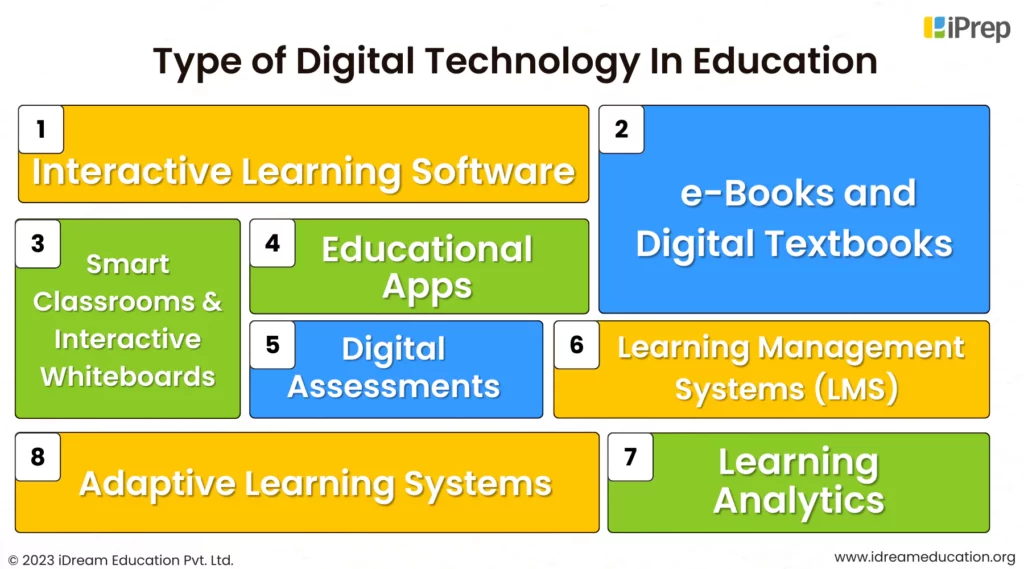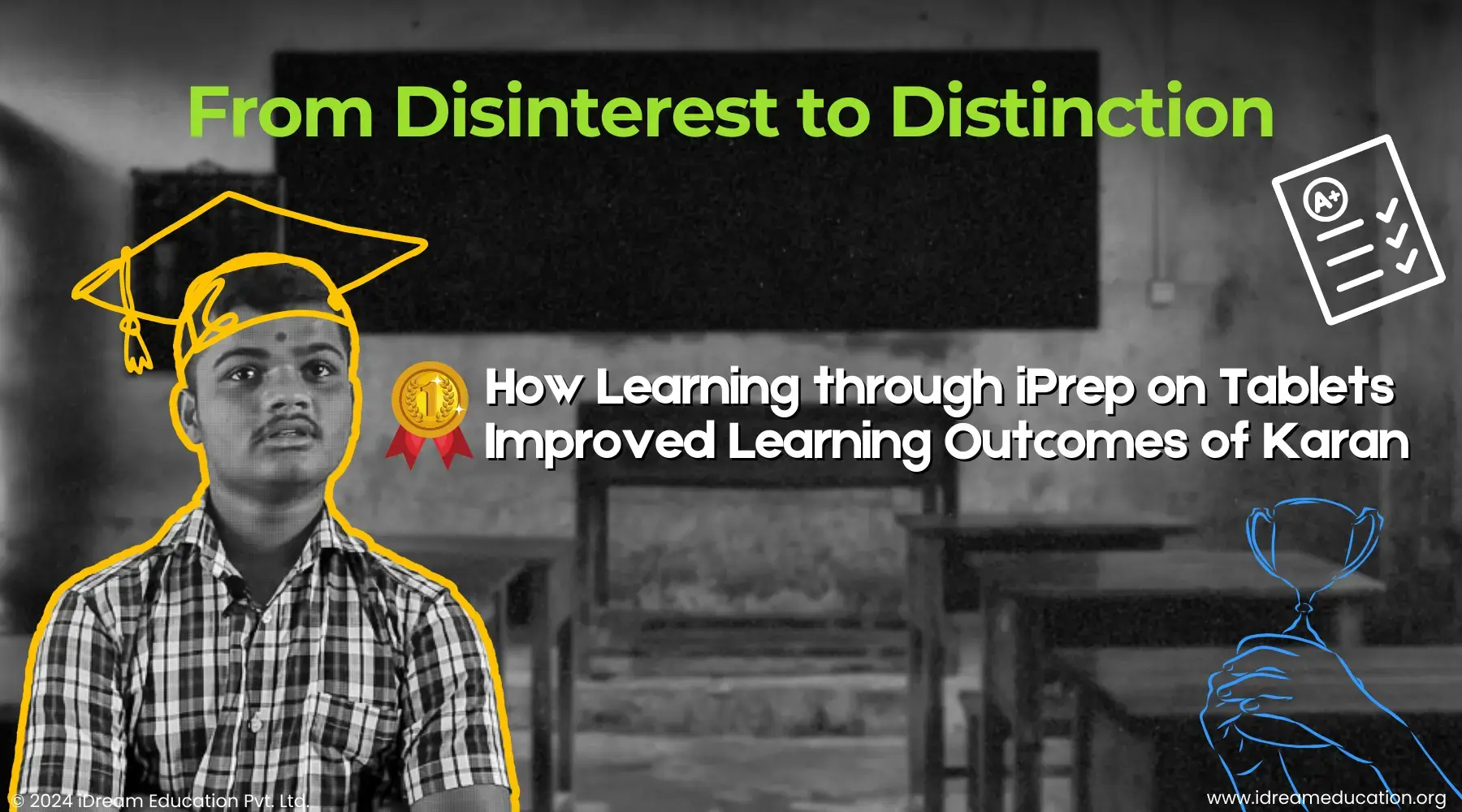Use Of Digital Technology in Education As A Supplement To Teaching And Learning At Schools

“Digital Technology” is a term that is not far away from becoming an integral part of anything and everything around us. Digital technology, like wildfire, is sweeping across our modern landscape, igniting transformation in every sector, especially education. Its rapid expansion is reshaping the way we learn, connect, and access information, bringing new opportunities and challenges as it blazes a trail into the future. That all together is creating a greater scope every day for Digital Technology In Education where it works as a supplement to both teaching and learning.
At iDream Education, we are committed to facilitating universal access to learning and growth. We imagine a future in which educational obstacles or barriers crumble, allowing students to start on an unending learning journey. The integration of digital technology into education is a critical step toward fulfilling this objective. In this blog post, we’ll uncover the various Advantages of using digital technology in education and how our digital learning solutions can add to the significance of these advantages. Let’s start with giving you clarity over what types of digital technology in education we are talking about.
What Types of Digital Technology In Education Are We Talking About?

When we discuss the integration of digital technology in education, it’s essential to define what we mean by “digital technology.” In the context of iDream Education’s vision to facilitate universal access to learning and growth, we’re referring to a wide array of technological tools and platforms that have the potential to supplement the educational landscape. Here’s a closer look at the types of digital technology that are making a significant impact-
1. Interactive Learning Software
Being one of the most promising digital technologies in education, Interactive learning software includes educational applications, simulations, and games designed to engage students while teaching them essential concepts. These software solutions provide a dynamic and immersive learning experience, fostering curiosity and a deeper understanding of subjects.
2. Learning Management Systems (LMS)
Learning Management Systems are again a prominent part of digital technology in education that has the power to supplement learning and teaching at schools. These are digital platforms that streamline the management of educational content and resources. Further, they enable teachers to organize course materials, assessments, and communication with students in one place, making it easier to deliver and track learning outcomes.
3. Smart Classroom Solutions
Smart classrooms are equipped with digital technology as the devices that these smart classrooms can be based on involve – Interactive Digital boards, Smart TVs, Digital White Boards, or smart projectors. All that to create an immersive learning environment. These tools facilitate real-time interaction and collaboration, making lessons more engaging and interactive.
4. Educational Apps
Educational apps encompass a wide variety of tools, from language learning apps to math practice apps, or to the one-stop learning apps that enable students to find everything they need to learn and grow in one single place such as the iPrep App. Further, these apps are accessible on tablets, smartphones, and computers, allowing students to learn on the go and personalize their educational journey.
5. E-Books and Digital Textbook
Digital textbooks provide students with a more interactive and portable alternative to traditional paper textbooks. Considered as the most convenient digital technology in education, these are mostly PDF versions of textbooks and one can have hundreds of these in one single device. Also, these do not get torn nor do they have any heavy weight for students and teachers to bear.
6. Adaptive Learning Systems
A highly promising and new-age digital technology in education is Adaptive learning systems. These use data and algorithms to personalize the learning experience for each student. They assess individuals’ current learning levels, their strengths and weaknesses, and tailor content accordingly, ensuring that students receive the support they need to excel such as the “iPrep PAL” app where PAL stands for Personalized Adaptive Learning.
7. Digital Libraries
Digital libraries can digitize the way students learn and grow in classrooms, libraries, and labs in school. These are smart ICT labs based on tablets, notebooks, android laptops. These devices are usually preloaded with rich digital content for classes 1st to 12th. So teachers can make students use them to learn and grow whenever and whenever they see fit. Talking about iPrep Digital Library, it comes with a charging trolley as well that charges all these devices at once and
8. Learning Analytics
The most important digital technology is the one that proves the legitimacy and effectiveness of these digital technologies in education. And it is none other than Learning analytics. It involves the collection and analysis of data related to student performance and engagement. This information allows teachers to make data-driven decisions and identify areas for improvement in their teaching methods and curriculum.
8. Digital Assessments
Digital assessment tools, including practice sets, quizzes, and assessments with the use of digital tools such as tablets, mobile phones, or laptops, enable teachers to evaluate student performance efficiently. They offer immediate feedback, helping students understand their areas of improvement. Making them an integral part of digital technology in education.
At iDream Education, our dedication lies in harnessing these digital technologies and integrating them into the education sector. Further, our iPrep platform leverages a variety of these tools to deliver a comprehensive and adaptive learning experience for students at schools, ensuring that they have access to the best of what digital technology has to offer.
By understanding the diverse range of digital technology used in education, we can appreciate the transformational potential of these tools in enabling universal access to learning and growth.
Advantages of Digital Technology in Education
Digital technology in education has significantly altered the methods of teaching and learning, presenting a multitude of benefits that possess the capacity to work as a strong supplement for the educational domain. Let’s examine the numerous advantages that arise from the incorporation of digital technology in education, with a specific emphasis on the types of digital technology mentioned earlier.
Advantage 1. Enhanced Interactivity and Engagement
An essential benefit of incorporating digital technology in education and further in the classrooms is that it can increase student interaction and engagement. Smart classroom solutions, interactive learning software, and educational applications all contribute to a dynamic and immersive learning environment. Students transition from being passive recipients of information to becoming engaged participants in the educational process. These interactive and entertaining learning tools stimulate inquiry and promote a more profound comprehension of various subjects.
The iPrep platform by iDream Education takes this benefit to another level. By utilizing iPrep’s interactive features and content, students are not only actively involved but also gain advantages from learning in both offline and online formats, which ensures a broad audience. The iPrep Digital Class for Smart Classrooms and its interactive learning tools foster an engaging atmosphere that encourages student participation, thereby enhancing the effectiveness and enjoyment of the learning process.
Advantage 2. Streamlined Management of Learning
One of the most prominent uses of digital technology in education comes in the form of Learning Management Systems (LMS). These facilitate the administration of educational resources and content through a centralized platform. By implementing this approach, the teaching and learning process is optimized. This facilitates teachers’ management of course materials, evaluations, and student correspondence. LMS enables teachers to more effectively deliver and monitor learning outcomes, which is ultimately advantageous for teachers and students.
The LMS on the iPrep platform from iDream Education simplifies the administration of student and teacher learning. By incorporating functionalities such as course organization, assessments, and communication tools, iPrep’s Learning Management System (LMS) optimizes the workflow of teachers, enabling them to allocate greater attention to pedagogical tasks. This leads to the establishment of a meticulously organized educational setting that maximizes the learning experience of the students.
Advantage 3. Personalized Education
In the realm of education, digital technology enables individualized learning experiences. Utilizing data and algorithms, adaptive learning systems, such as the iPrep PAL app, customize material to the specific strengths and areas of improvement deficiencies of each student. This individualized approach guarantees that students obtain the necessary assistance to thrive, thereby enhancing the efficacy and efficiency of education.
iPrep PAL by iDream Education is an advanced level of personalization. Through the process of evaluating distinct learning levels and customizing material accordingly, iPrep PAL guarantees the fulfillment of the unique requirements of each student. By providing students with a personalized adaptive learning experience, academic achievement is optimized and the learning process is further streamlined and effective.
Advantage 4. Adaptability and Accessibility
The use of Digital technology in education increases the adaptability and accessibility of education. Digital textbooks and educational applications are accessible on a wide range of devices, such as computers, tablets, and smartphones. This adaptability empowers students to engage in self-paced learning and personalize their academic trajectory. Moreover, the portability and sturdiness of digital textbooks obviate the necessity for burdensome luggage stuffed with conventional paper textbooks.
The iPrep platform here provides a variety of digital solutions, one of which is the iPrep App, which functions as a centralized learning environment compatible with almost all devices and operating systems. Students can access their educational resources at any time and from any location due to this adaptability. The provision of educational materials in numerous languages contributes to increased accessibility, thereby fostering a more flexible and inclusive environment.
Advantage 5. Digitally Rich Content
Smart ICT laboratories and digital libraries grant students access to a wealth of digital content, thereby enriching the educational experience. These educational materials provide students with an abundance of information and interactive components, enabling them to independently investigate and acquire knowledge. By utilizing digital libraries, teachers can supplement their teachings and captivate students with an assortment of multimedia materials.
The iPrep Digital Library here is an all-encompassing resource that includes a charging trolley designed to accommodate tablets, notebooks, or Android laptops. In addition to furnishing students with an extensive digital library, this practice guarantees that the devices are consistently reconditioned and operational. Teachers and students benefit from an enhanced learning environment due to the convenience and wealth of digital resources provided by iPrep’s Digital Library.
Advantage 6. Constant Feedback
Another added advantage of using digital technology in education is the digitization of assessments. Digital assessments and learning analytics provide teachers and students with immediate feedback. Digital assessment tools, such as practice sets and exams, offer prompt and relevant evaluations of student performance.
This feedback enables teachers to better support their students’ needs by enabling them to modify their teaching methods and curriculum and by assisting students in identifying areas for improvement. Not just that, with digital assessments, teachers can ensure accuracy in recording the learning progress of the students
The iPrep platform comprises digital assessment instruments that provide instantaneous feedback messages carrying the logic behind the question. Teachers can track student progress and identify areas in which students may require additional assistance by utilizing these tools. The provision of immediate feedback through iPrep’s assessment tools enables Teachers to assist students in optimizing their learning and empowers learners to assume responsibility for their development.
Advantage 7. Eco-friendly and economical
The use of digital technology in education can be environmentally beneficial and cost-effective. Schools can achieve cost savings and environmental sustainability by decreasing their reliance on physical textbooks and paper assessments. In the long run, digital resources are frequently more cost-effective due to their capacity for effortless updating and sharing among students.
The iPrep Tablets for Preloaded Learning Devices with Monitoring provide an economical substitute for conventional paper textbooks. The preloading of digital content onto these tablets eliminates the need to purchase physical textbooks. In addition, the monitoring function maximizes the value of the devices by ensuring that they are utilized for educational purposes. This environmentally favorable and economical strategy enhances the sustainability and effectiveness of the education system.
Advantage 8. The Utilization of data-driven decision-making
When it comes to digital technology in education, the track of progress and efficiency can never be missed. These technologies come with learning analytics that enables teachers to make decisions based on data. Through the collection and analysis of data about student engagement and performance, Teachers can discern domains in which their instructional approaches and curriculum may be enhanced. The utilization of a data-driven approach enables Teachers to consistently improve the caliber of instruction they deliver.
The iPrep platform facilitates data-driven decision-making through the provision of extensive data on student performance. At every moment iPrep records the usage of the platform irrespective of the solutions being used. The same usage data is then presented in the utmost detailed analytical format in the My Reports section. The same gets synced with our central reporting dashboard called the iPrep Reporting Dashboard when the device is connected to the internet.
Teachers can monitor student progress, identify strengths and weaknesses, and make well-informed decisions to improve the learning experience by utilizing the My Reports section. Further, by utilizing the data-driven methodology, teachers can consistently enhance their pedagogical approaches, which ultimately results in improved academic achievements for students.
This doesn’t stop here
At the same time, with access to the iPrep Reporting Dashboard, school-level educational stakeholders such as School principals, Trustees, and heads of departments better plan the course of action for their schools. Beyond schools, educational stakeholders such as educational NGOs, educationists, government departments, and Socially Responsible Corporations (CSR), and philanthropists & giving organizations can enable digital Technology in Education by investing in education programs or donating to education or digital learning. Altogether, apart from better planning CSR initiatives in Education or development initiatives in Education, those who can invest in the area of education can better plan their initiatives and interventions and ultimately prove the legitimacy and effectiveness of their investments and impact on education with access to the iPrep Reporting Dashboard.
Let’s Conclude
At iDream Education, our commitment to harnessing the power of digital technology in education is unwavering. Through our iPrep platform, we leverage a multitude of these tools to offer a comprehensive and adaptable learning experience for students in schools, ensuring that they have access to the best that digital technology has to offer. As we explore the diverse array of digital technologies used in education, we begin to grasp their transformational potential in making learning and growth universally accessible.
The advantages are evident – enhanced interactivity, streamlined management, personalized education, adaptability, rich content, constant feedback, eco-friendliness, and data-driven decision-making. These are not just technological advancements; they are the stepping stones to a brighter future where every student can Learn Unlimited.






